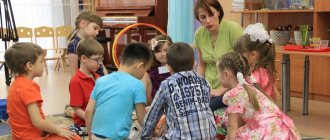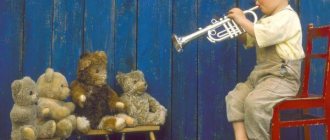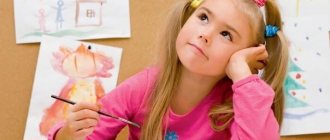One of the significant indicators of a child’s harmonious development is his vocabulary - the volume of words that he uses in the process of communication and learning.
Experts have calculated that at the age of one and a half years, the vocabulary of young children can number no more than 50 words, and by the age of five, children are already fluent in 2000–2500 words. However, not only the quantitative indicator is important (how many words the child uses), but also the qualitative one - how much he understands the meaning of the words he uses, whether he uses the necessary word forms correctly.
That is why the development of the vocabulary of preschool children is a very important area in preschool education and upbringing.
Preschooler vocabulary development
The norm at the age of one and a half years is considered to be a vocabulary of fifty words; by the age of five, a child should be able to handle two thousand or more. At first, the child’s speech is enriched by the concepts that he hears from adults. The development of a preschooler’s vocabulary occurs through communication in the family and among peers. But you shouldn’t leave speech formation to the environment - vocabulary develops through reading, educational games, and constant discoveries that the child makes with the help of an adult. You can develop your reserve with the help of games and exercises. Already from the first year of a child’s life, it is necessary to enrich his speech; this will save him from possible delays and failures in school education and in communicating with peers.
Conversations
From the age of 3, the child already understands the meaning of the text and understands the content of poems and fairy tales that his mother reads to him. Therefore, you can discuss the books you read or the illustrations you viewed. Effective exercises:
- the child tells what is shown in the pictures and makes up stories based on them;
- the child answers questions based on the text he just listened to (good questions: who did you like best? what event do you remember? what would you do in the hero’s place? why?);
- the child describes an object in detail (parents can ask clarifying questions: what shape is it? what color?).
To learn the names of body parts and items of clothing, have your child describe himself or a doll.
Reading fiction
Be sure to read aloud to your child. After all, reading fiction is the most important way to enrich your vocabulary. Children who have loved books since childhood have more developed speech than their peers, are able to construct sentences correctly, and write essays better in school.
When reading a book to your child, try to pronounce words clearly, loudly and correctly, and avoid mistakes in articulation and emphasis. If there are unfamiliar words in the text, explain their meaning to the baby.
Active and passive vocabulary
There are active and passive vocabulary. The first is the set of words that the child uses every day, which is most convenient and habitual for him to use. It is used in written and oral speech. Passive vocabulary is those words and concepts that the child has encountered in books and heard, but uses extremely rarely. These include, inter alia, historicisms, archaisms, neologisms, and borrowed foreign words.
Replenishment of these reserves occurs throughout a person’s life; each age exhibits its own characteristics of vocabulary formation. Until the age of six, active and passive reserves are still a rather vague concept - speech is enriched with new words, many of the new ones become familiar. With age, the passive reserve becomes significantly larger than the active one. Only the ability to use one’s knowledge makes a child, and later an adult, the owner of real linguistic wealth. What helps a child activate his vocabulary:
- Observation
- Communication with peers and adults
- Borrowing
- Reading, reading analysis
Often a child knows a lot of words, but is embarrassed to use them, or does not find the right moment, and the words lie like a dead weight. To prevent this from happening, you need to translate words from a passive vocabulary into an active one, explaining their meanings, coming up with a situation for their use, that is, giving them an independent life in the baby’s speech through pronunciation. You can select examples from the literature.
Vocabulary techniques
The methodology for developing the vocabulary of preschool children involves the use of a variety of techniques, each of which is aimed at helping children identify the right word in speech, understand its meaning and place of use in their own colloquial speech. Several techniques can be used simultaneously within one method.
Basic techniques for developing vocabulary for preschool children:
- Naming a word by the teacher - used as a model for pronunciation of a new or difficult word. The teacher’s task is to pronounce the word clearly and understandably for all students.
- Showing an object is used when a new word is difficult to understand with just one explanation. For example, when explaining the word “oven,” a teacher can use a toy stove or a picture.
- Interpretation - used when introducing children to a foreign word or a little familiar one. For example, an aquarium is a glass box in which fish live.
- Including words in a sentence is used if the understanding of a new word will be better within a specific context.
- Repetition - used to better memorize a word. Repetition should be repeated both during the training session and throughout the day.
- Explanation of the etymology of a word - used in older groups, used to strengthen the explanation, develop curiosity and sensitivity to language.
- Question - a technique used to activate the vocabulary, involves the teacher addressing the children, and the question asked can be either direct or suggestive.
Note 2
All techniques can be used either individually or in combination within a specific method. In addition, the techniques can be used when conducting didactic games and activities to familiarize themselves with the outside world. It is only necessary to take into account their accessibility to children.
Replenishing a child’s vocabulary with different types of parts of speech
Between one and three years of age, a child remembers the following:
- what are the names of your loved ones;
- what are the toys called?
- how household items are designated (food, dishes, hygiene items, etc.)
- natural phenomena;
- Seasons;
- easy names of plants and animals
A child’s vocabulary at this age has not yet been replenished with words that allow him to clearly express his assessment or emotions.
By the age of four or five, a child’s speech is already filled with a larger volume of words; he operates in a completely different way with concepts that have already been learned. What does a preschooler remember at this time:
- Labeling feelings (sad, happy, angry, etc.)
- Qualitative characteristics of objects (low, cold, light, etc.)
- How to correctly create a diminutive form of the word (son, daddy)
- Cognate words: (rook-rook; cat-kitten-cat)
By the age of five or six, a preschooler, as a rule, has already mastered about three thousand or more words; he knows the following:
- Time designation - days, weeks, hours, minutes, etc.
- Designation of space - right, left, sideways, etc.
- Simple and complex numbers
- The name of peoples, countries, the designation of social phenomena - labor, state, etc.
The child increases his stock of verbs and nouns most quickly, and adjectives more slowly. Since it is this part of speech that gives imagery to the conversation and saturates it, adults should pay attention to the descriptive and qualitative characteristics of objects and phenomena.
Observation with comments
From the very birth of the baby, start talking to him: the baby must get used to the sound of human speech. Lesson options:
- While walking, tell your baby everything you see. Try to make the story picturesque and figurative: use many adjectives, use synonyms. An example of a good description: “This is a tree. It is green, bright, with lush foliage. And how big, tall and majestic it is! This is a truly gigantic tree!” Try to comment on events emotionally: say how you feel from contemplating a rainbow or how you feel when a hot object touches your hand.
- An eight-month-old child can already be taught about the structure of the body. Touch it and say: “This is a pen, your pen; little pink hand." Then show your hand and say: “This is my hand: look how big it is.” Remember to use as many adjectives as possible.
- Organize a joint observation of something: a pet, an insect, a tree swaying in the wind, or something happening on the street. At the same time, comment on what is happening: “Look, a grasshopper is crawling along a leaf. Now he moved his paw. Funny, isn't it? Oh, that’s it, he galloped away.” If possible, let your child touch, smell, or even lick the observed object.
- You can conduct several experiments with your child. Bring his hand to the cat’s fur and say: “This is a cat; It’s soft, warm and smooth.” Then invite the baby to hold a piece of ice and say: “This is cold, hard and wet ice.”
- From the age of 2, you can purposefully introduce new lexical units into your child’s vocabulary. To do this, you must demonstrate the object to the child, say its name several times and make sure that the baby remembers it. Try to do it naturally. On a walk, as if by the way, show him a tree and say: “This is a spruce.” Point to another spruce and say again: “And this is a spruce.” Then, pointing to the tree, ask: “Do you think this is a spruce?” To make sure that your child remembers the word, point to the spruce and ask: “What kind of tree is this?”
Expanding your vocabulary with games and activities
How does the mechanism for enriching a child's vocabulary work? The child first hears the word, then understands what it means, remembers it, and only then begins to put it into practice. Almost all games and tasks for replenishing a child’s vocabulary are built on this scheme.
"Conductor". The game is built on the trust of an adult in a child. The companion asks the baby to accompany him. He closes his eyes and allows the baby to talk about everything he saw on a walk or at home. At the same time, the child is reminded that he needs to describe in as much detail and accurately as possible everything that he sees around him. An additional condition may be a request not to use the same words.
"Ball Game" Such exercises develop vocabulary and logic, generalize knowledge in the field of lexical groups. For example, the leader throws a ball, and everyone who catches it must name a new animal. Anyone who fails to do this is eliminated from the game. The same game can be played with the names of fruits, plants, vegetables, etc.
A variant of the same task is “who lives where?” The presenter throws the ball, asking: “Who lives in the ocean?”, “Who lives in a tree?”, “Who lives in the forest?”. Children answer in turns, inventing new inhabitants of the above-mentioned places. This exercise helps expand vocabulary and develop knowledge about the environment.
"Big small". In this exercise, the preschooler forms words with a diminutive meaning. The presenter says “mom”, the child answers “mommy”; The leader throws the ball, saying “table”, the child throws it back, saying “table”, and so on. This is not the easiest task, so the kids are given time to think about the answers.
Variant of the ball game “Edible-inedible”. The host names what you can eat, the children name what you can’t, and vice versa.
"Package". Each player receives an oral “package” (the presenter tells him in confidence what is in it). Participants describe their package so that others can guess what is in it
"Analogies". Children learn to derive “vocabulary formulas.” On the paper it is written: “a cat is an animal, a sparrow?” The child’s task is to assign the word to a specific thematic group.
“Finish the sentence.” The adult says the phrase, but does not finish it, and the child comes up with the ending. For example: “The cat jumped on the table, and...”; “Katya woke up, went to the window and saw...” The older the child, the more varied the stories will be. From such sentences, you can compose a whole fairy tale with your child.
Innovative speech therapy technologies: syncwine
"Find the object." The adult thinks of a letter, the child finds objects that begin with it.
“Pick up a word.” The adult names the adjective, and the child looks for a noun for it. For example, the table and bread can be hard. Soft - a blanket and a cat. Then the rules change. The presenter says a noun, the participant selects an adjective. Sugar – sweet, crumbly; snow – wet, cold.
When choosing games and activities, you should take into account the child's temperament. Active preschoolers will enjoy playing ball; calm children will enjoy a descriptive exercise, when they need to analyze phenomena, name objects and talk about what they saw.
These and other games that you can come up with yourself will not only replenish your child’s verbal skills, but will also increase his self-esteem and make him have fun. Most of these tasks take no more than fifteen minutes and can be done on the way to the garden, on a walk, or at home. Experts recommend ending the game before the child himself asks for it. Then he will want to continue it tomorrow and the next day.
Vocabulary development for preschool children
Galina Khlabystina
Vocabulary development for preschool children
Annotation. The article discusses the tasks and content of vocabulary work , the sequence of learning new words , and methods of working with preschoolers to enrich the vocabulary .
Key words : passive dictionary , active dictionary . vocabulary work , tasks, content, methods of work.
Enrichment of vocabulary is one of the essential tasks of speech development in children of preschool and primary school age . Work on the development of children's speech and vocabulary begins in kindergarten. In preschool methods of speech development, this aspect is presented primarily in the works of A. M. Bogush, N. V. Gavrish, M. M. Konina, O. I. Solovyova, E. I. Tikheeva, V. I. Yashinoya and others.
Today it is customary to distinguish four main tasks of dictionary work :
- Firstly, enriching the dictionary with new words , children learning new words that they did not know before, as well as new meanings of words . The enrichment of the dictionary occurs , first of all, due to commonly used vocabulary (names of objects, their characteristics and properties, actions, processes, etc.).
— Secondly, consolidation and clarification of vocabulary . This task is due to the fact that for children the word is not always associated with the idea of an object; they do not always know the exact name of the objects. Therefore, it is necessary to fill them with specific content.
— Thirdly, activation of the dictionary . As you know, all acquired words are divided into two categories: passive vocabulary and active vocabulary . The passive dictionary includes words that preschoolers know but do not use in their speech. Active vocabulary includes words that children have learned and use in their oral speech.
— Fourthly, eliminating non-literary words (dialectal, slang, colloquial, low meaning)
.
This is especially necessary in unfavorable speech environments . Children often do not even realize that these words spoil and pollute their language. Therefore, it is necessary to explain and teach preschoolers to use appropriate literary words .
The content of vocabulary work in preschool age is determined by the fact that first vocabulary must denote elements of material, intellectual and socionormative culture. From this point of view, the content of dictionary work includes words that mean:
• household dictionary - names of body parts, faces, names of toys, dishes, furniture, clothing, toiletries, food, premises;
• natural history dictionary - names of inanimate natural phenomena, plants, animals;
• social science dictionary - homeland , national holidays, people’s work, etc.;
• emotional-evaluative vocabulary - words denoting emotions, experiences, feelings, qualitative assessment of objects, synonyms, phraseological combinations, etc.;
• words denoting time, space, quantity.
In grammatical terms, children become familiar with words that relate to independent and auxiliary parts of speech (without introducing terms)
.
According to methodologists, a child learns a new word in a certain sequence, namely: a) a feeling of individual properties of an object; b) perception of a holistic image; c) formation of an idea of the subject, concept; d) reflection of the concept in the word [1 , 162].
Preschoolers better learn the meaning of a new word by showing natural object clarity. Explanation of the word by demonstration must be carried out as follows:
a) display of natural objects (top, hat, eggplant)
b) display of stuffed animals, models, dummies (grouse, swift, starling)
c) display of drawings, transparencies, slides (shark, perch, lynx)
.
Children watch movies, attend performances, watch programs on television, listen to the radio, quickly memorize new words , but sometimes not clearly understanding their meaning. The teacher must help understand the meaning of these words and translate them into the child’s active vocabulary . After introducing new words, they need to be consolidated . E. I. Negnevitskaya recommends doing it in a certain sequence: recognizing a word , selecting it with visual clues, selecting a word without visual clues [2,63].
reinforce new words during the game . For example, the game “Forbidden words .” The didactic task of the game is to teach children to arbitrarily and consciously select words that match their meaning. Rule of the game: make sentences without using “forbidden words .” Progress of the game: children are asked to answer the teacher’s question with a sentence without using "forbidden words ". The one who makes the most sentences wins. The teacher’s questions could be:
- What is the kitten doing? (Forbidden words : plays, meows)
.Variant answer: The kitten washes itself with its paw, drinks milk, and cuddles.
The leading principle of introducing new words is to group them by topic. For each general topic, the teacher compiles a thematic dictionary for the entire period of study. This allows you to include words in active conversational speech, build a dialogue on a relevant topic, and compose a story.
To these forms of work you can add such as: explanation of words by using context, introduction of new words into sentences , selection of synonyms, antonyms, use of word forms in different phrases , exercises on creating new words using suffixes and prefixes.
A major role in enriching children's vocabulary is played by the speech of parents, the environment, and in kindergarten - the teacher, and therefore the teacher's speech should not only be correct in structure, but also rich, meaningful, and varied in its vocabulary .
In order to develop children's skills in independently using words with a figurative meaning, methodologists recommend introducing exercises for replacing the direct meaning of words with synonymous words or expressions that have a figurative meaning, as well as exercises for independently composing sentences with words in a figurative sense . Such exercises instill in children an attentive attitude to words and develop a sense of language .
Work on studying the polysemy of words involves : a) awareness that a word can have not one , but several meanings; b) accuracy of the use of polysemantic words in speech .
For this purpose, the following work can be recommended:
— Explanation and comparison of the meanings of polysemantic words in context : the wind sways the silk grass; Our Tanya has a silk scarf.
— Selection of words (synonyms)
to each meaning of a polysemantic
word : hot pepper - bitter, hot;
— Selection of words of opposite meaning (antonyms)
: a joyful event is a sad event.
Among the methods of working with preschoolers on polysemantic words, methodologists call the following effective:
- constructing sentences with ambiguous words ;
- drawing on the topic of a polysemantic word ;
- finding polysemantic words in sayings , riddles, proverbs and in literary works - fairy tales, stories;
- writing stories and fairy tales on the theme of polysemantic words [3 , 21].
In order to expand the active vocabulary of children , the teacher uses exercises of a creative nature, such as: making sentences in which a certain specified word would be used in different meanings, describing objects whose name is a polysemantic word .
Thus, the timely development of a preschooler’s vocabulary is a sign of well-developed speech , an indicator of a high level of mental development , and one of the important factors in preparation for school.
Literature
1. Bogush A. M. Teaching correct speech in kindergarten / A. M. Bogush. – K.: Glad. school, 1990. - 212 p.
2. Negnevitskaya E, Sokhina F. Methods of teaching the Russian language in the national kindergarten. / Negnevitskaya E, Sokhina F. - M.: Education, 1995. - 144 p.
3. Strunina E, Ushakova O. Semantic aspect in the development of speech of older preschoolers // Development of speech and speech circulation of preschoolers . / Strunina E, Ushakova O. - M., 1995.







